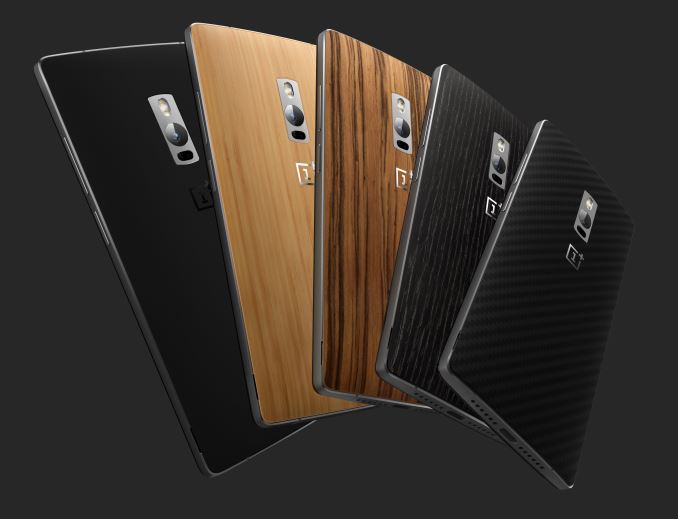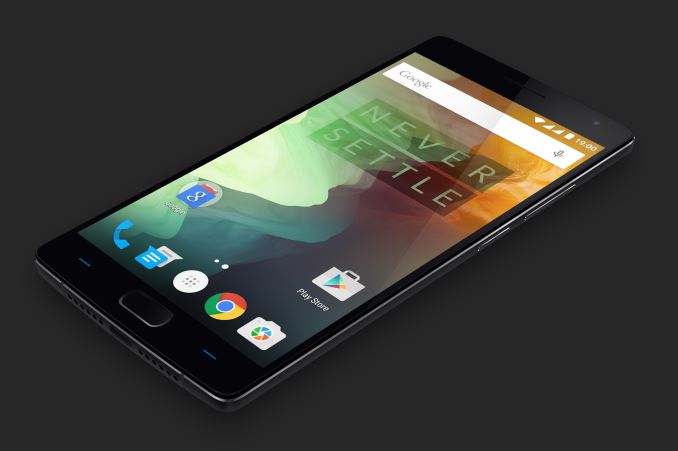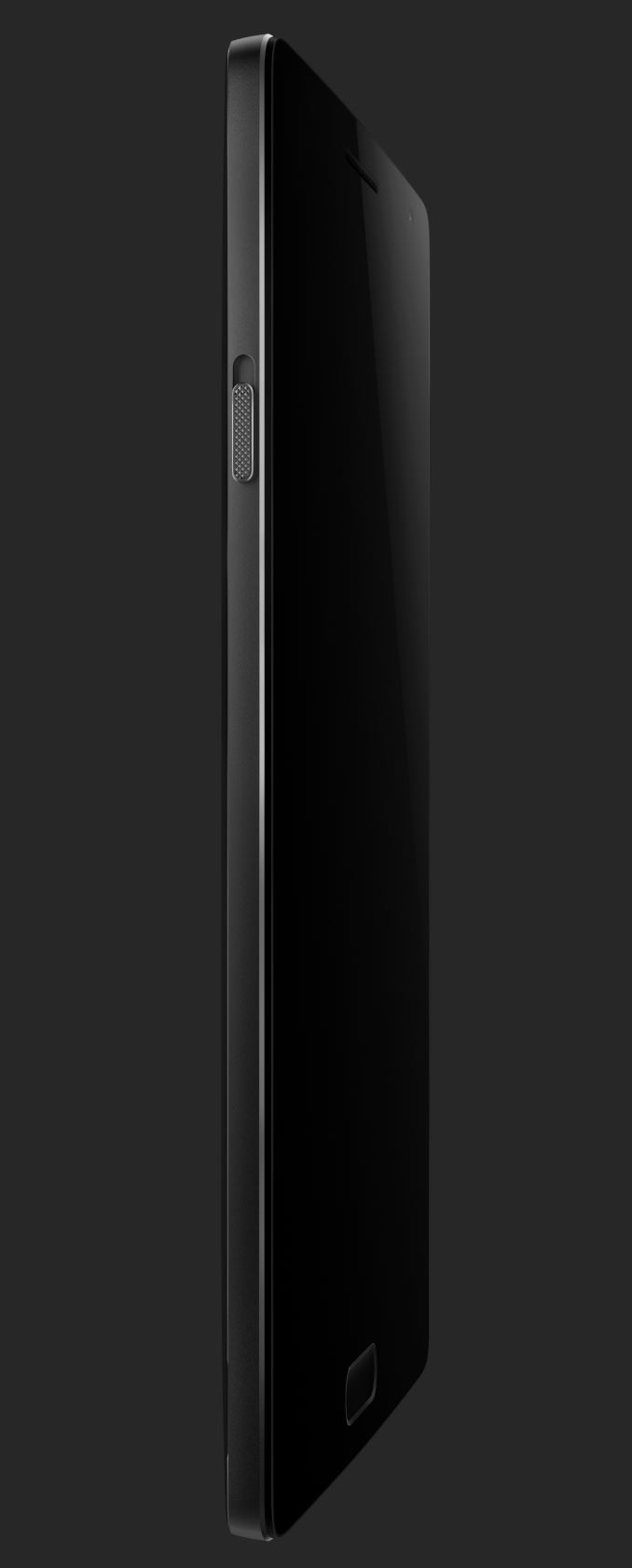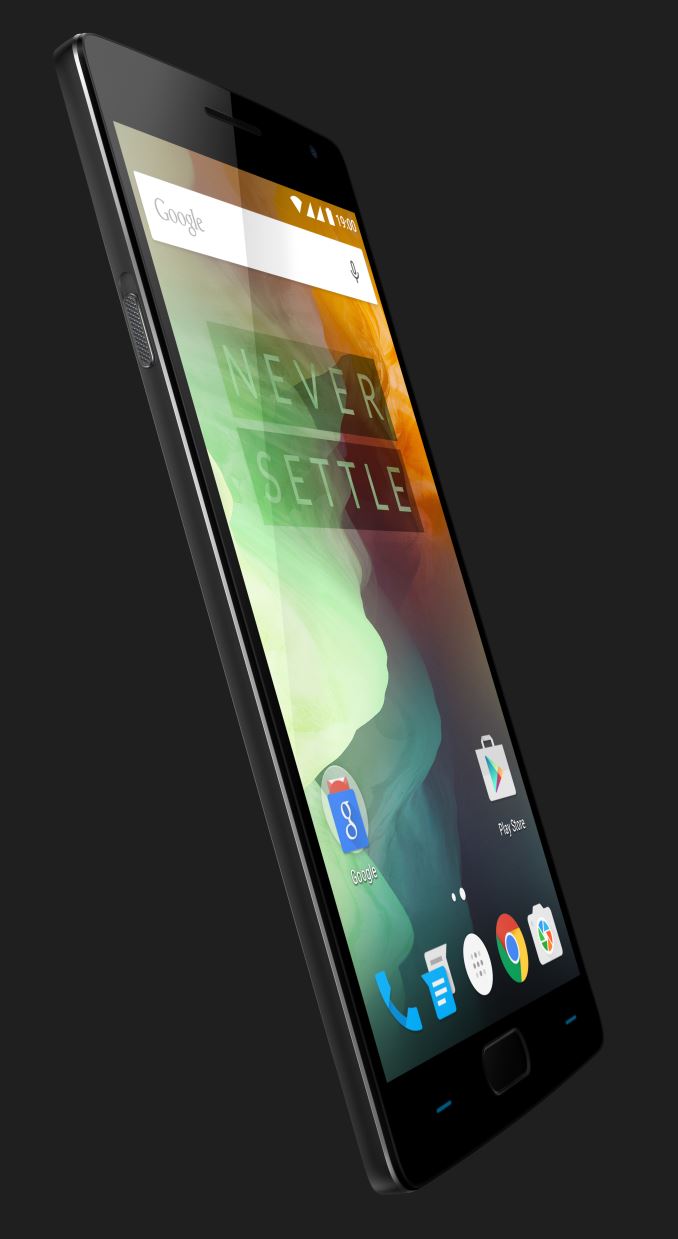OnePlus Announces the OnePlus 2: 389 USD High-End Flagship
by Joshua Ho on July 27, 2015 10:02 PM EST- Posted in
- Smartphones
- Qualcomm
- Mobile
- Snapdragon 810
- OnePlus
- OnePlus 2

OnePlus showed up on the scene last year with a “flagship killer”, the OnePlus One. For those that are unfamiliar with this device, it brought a Snapdragon 801 SoC, 5.5” 1080p display, and some generally impressive hardware at a 350USD price point for the 64GB variant. This made the OnePlus One a pretty incredible value, and to OnePlus’ credit the One remains one of the better choices in the midrange market due to its high-end specs. Today, OnePlus is launching the successor to their first device, which is called the OnePlus 2. To establish some of the basic specifications of this device I would refer to the spec table below.
| OnePlus One | OnePlus 2 | |
| SoC | Snapdragon 801 2.5 GHz Krait | Snapdragon 810 1.8 GHz A57/A53 |
| RAM | 3GB LPDDR3 | 3/4GB LPDDR4-1555 |
| NAND | 16/64GB NAND | 16/64GB NAND |
| Display | 5.5” 1080p IPS |
5.5” 1080p IPS |
| Network | 2G / 3G / 4G LTE (Category 4 LTE) | 2G / 3G / 4G LTE (Category 6/9 LTE) |
| Dimensions | 152.9 x 75.9 x 8.9mm, 162g | 151.8 x 74.9 x 9.85mm, 175g |
| Camera | 13MP Rear Facing (Sony IMX214) f/2.0, 1.1 micron 1/3.06" sensor | 13MP Rear Facing w/ OIS and laser AF, f/2.0, 1.3 micron 1/2.6" sensor |
| 5MP Front Facing | 5MP Front Facing | |
| Battery | 3200 mAh (12.16 Whr) | 3300 mAh (12.54 Whr) |
| OS | Android 4.4 w/ CM11S (At Launch) | Android 5.1 w/ OxygenOS (At Launch) |
| Connectivity | 1x1 802.11a/b/g/n/ac + BT 4.0 (WCN3680), USB2.0, GPS/GNSS, NFC |
802.11a/b/g/n/ac + BT 4.1, USB-C, GPS/GNSS |
| Fingerprint Sensor | N/A | Touch |
| SIM | 1x MicroSIM | DSDS NanoSIM |
| LTE Bands | Global: 1/3/4/7/17/38/40 | US: 1/2/4/5/7/8/12/17 EU: 1/3/5/7/8/20 |
| Launch Price | $299 (3GB/16GB) $349 (3GB/64GB) |
$329 (3GB/16GB) $389 (4GB/64GB) |
As one can see, the display size and resolution is unchanged from the OnePlus One, but OnePlus is promising higher static contrast at 1500:1, relative to the ~1000:1 contrast of the One. This is likely due to the use of photoalignment technology, which seems to have become an industry standard within the past few months. The 1080p resolution is sufficient for a 5.5” smartphone, although an increase to 1440p would be noticeable I suspect that OnePlus is responding to demands for improved battery life over higher display resolutions. The OnePlus 2 also has the somewhat standard Snapdragon 810 for a high-end smartphone, although it’s notable that the maximum frequency of the A57 cluster has been capped to 1.8 GHz in order to improve thermal performance. It isn’t clear if OnePlus is also using hotplug or other mechanisms to only use two big CPU cores either, but this will take a review to really figure out what’s going on. Battery also receives a minor size increase from 3200 mAh to 3300 mAh, presumably at a 3.8V nominal voltage. The lack of microSD expansion likely comes from user experience concerns, as is the non-removable battery. The OnePlus 2 also has a significant improvement to materials, as the frame is an alloy of aluminum and magnesium while the OnePlus One was only made of plastic on the outer casing.
The other major change is the camera. It seems that OnePlus has elected to use a 13MP, 1.3 micron camera sensor with OIS integrated into the module and laser auto focus. The 13MP 1.3 micron sensor is likely to be the OV13860, which means that the sensor format is similar to both the LG G4 and Samsung Galaxy S6, but with a larger pixel size to improve low light performance to reduce read noise from the sensor. Optical stack details remain unknown but the aperture stays at f/2.0 to balance distortion and low light performance. OIS is also introduced to improve low light photo performance for longer exposures. Laser AF is also added to reduce AF speed, a weakness that was present in the OnePlus One. Given the look of this laser AF mechanism, I suspect this is ST-M's time of flight sensor which means that this sytem will be most effective within 10cm of the laser AF sensor.
OnePlus has also introduced some new features in the form of a notification switch, fingerprint sensor, and USB-C port. The notification switch allows for fast switching between all, priority, and no notifications somewhat similar to the iPhone’s mute switch. The fingerprint sensor is also said to be better and faster than the iPhone 6’s TouchID sensor. It’s also purely capacitive, which should make it unlikely to fail over time and you can turn the phone on and unlock it only by using the fingerprint sensor, which would make the experience similar to the HTC One M9+ and Huawei Ascend Mate 7. The addition of USB-C is also great to see, as this makes OnePlus one of the first OEMs to adopt the reversible USB connector standard although it isn’t clear if all of the various features that come with USB-C will be adopted with the launch of Android M.
The OnePlus 2 will be available starting August 11 in select countries for the 64GB storage variant. The 3GB/16GB model will be 329 USD, and the 4GB/64GB model will be 389 USD. StyleSwap covers, which allow you change the back cover’s look and feel, will also be available, with black apricot, Kevlar, bamboo, rosewood, and sandstone black options.














90 Comments
View All Comments
peterfares - Tuesday, July 28, 2015 - link
Marketing BS. Apparently having an SD card slot is bad for performance which is laughable. The only performance hit would be if you installed apps to the SD, but they could have just disabled that in the software if they wanted to avoid users doing that.tyger11 - Tuesday, July 28, 2015 - link
"The lack of microSD expansion likely comes from user experience concerns" likely comes from bullshit from Google & Apple.Gigaplex - Tuesday, July 28, 2015 - link
As a Galaxy S4 owner who eventually got upgraded to KitKat, I'm not surprised that there were user experience concerns. KitKat gimped the SD card support. Luckily rooting the device allowed me to revert the restrictions.victorson - Tuesday, July 28, 2015 - link
This. It's frustrating to read marketing BS in an Anandtech article.Poik - Tuesday, July 28, 2015 - link
It's partially BS but caused by stupid users buying the shittiest SD card they can find and then complaining about how music or photos or apps or whatever lags or crashes.I have a Lexar 633x and while apps might be different photos and camera and videos all run great. Sadly many people have the Walmart special and everything runs like crap.
Drumsticks - Tuesday, July 28, 2015 - link
To be fair, they have a 64GB SKU and $389 is a pretty good price for what you get. That's not to say I disagree with you, but if a compromise has to be made, they picked a good one, at least relative to the rest of the market.zodiacfml - Tuesday, July 28, 2015 - link
Right.sonicmerlin - Tuesday, July 28, 2015 - link
Most people will buy the cheaper 16 GB version and surprised there's no way to expand storage .Impulses - Tuesday, July 28, 2015 - link
Most people won't even care to look for expandable storage because they're already used to not having it or never used it to begin with... They will buy the 16GB model tho and many will run into issues a year later when they can't install anything because their phone is full of photos/videos they never delete.Enthusiasts tend to think about how few videos they can get on internal storage, or backups, or whatever other esoteric thing the average consumer just never really partakes of. The average consumer streams almost everything now and media they create and don't manage properly ends up being the real storage sink.
NeBlackCat - Tuesday, July 28, 2015 - link
"No way to expand storage"There is - micro USB flash drive. I've found this works great along with the 64GB internal storage on the 1+1.